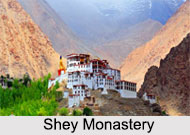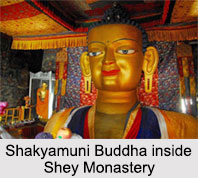 Shey Monastery is situated on the upper Indus Valley, which is 15 km east of Leh, in the region of Ladakh. Zanskar range of hills is on the southern side of the monastery in the fertile Indus River Valley with an average elevation of 11, 204 feet. Located on the top of hill, Shey monastery offers a scenic view of the surroundings of Thikse, Stakna, Matho, Stok and also Leh.
Shey Monastery is situated on the upper Indus Valley, which is 15 km east of Leh, in the region of Ladakh. Zanskar range of hills is on the southern side of the monastery in the fertile Indus River Valley with an average elevation of 11, 204 feet. Located on the top of hill, Shey monastery offers a scenic view of the surroundings of Thikse, Stakna, Matho, Stok and also Leh.
History of Shey Monastery
Shey Monastery is located inside the Shey Palace. The palace, which is almost in ruins now, was built first in 1655, near Shey village, by the king of Ladakh, Deldan Namgyal. At that time, the palace was used as a summer retreat by the kings of Ladakh. The Shey Monastery was also built in 1655 inside the palace complex on the instructions of Deldon Namgyal, in the memory of his late father, Singay Namgyal. The monastery is noted for its giant seated Shakyamuni Buddha. Shakyamuni Buddha is so named since Buddha was the saint (muni) of the Sakya people who resided in the Himalayan foothills and their capital was Kapilavastu. It is said to be the second largest such statue in Ladakh.
Architecture of Shey Monastery
Shey monastery is renowned for a two-storey high statue of a seated Buddha which was installed by King Deldan Namgyal. The statue is 12 meter in height and is crafted with copper sheets gilded with gold. This Buddha statue is said to be the second largest in Ladakh.
The wall behind the statue has the images of Buddha`s two chief disciples, Sariputra and Maudgalyayana. Directly in front of the Buddha, to the right, is a statue of a blue horseman, Paldan Lamo and to the left is a statue of the red horseman of Chakmen, representing the king of Ladakh. And the walls on both sides display the 16 Arhats.
The upper floor of the monastery is decorated with various wall paintings. The lower floor consists of a library which houses a large number of neatly preserved manuscripts. It is adorned with murals of Buddha figures in different hand gestures; that of preaching, teaching, blessing, "earth witness" etc. At the edge of the valley, there is an official residence of the Lama of the monastery.
 Worshipping in Shey Monastery
Worshipping in Shey Monastery
For worshipping the deities in the sanctum, grain, jewels, holy signs are offered with mantras. A number of butter lit lamps are placed in the shrine, which burn perpetually over a year. The lamps are then replaced with another to continue the flame without interruption. The lamps are a symbolic significance of the divinity and purity of the shrine.
Festivals of Shey Monastery
Shey monastery organises two seasonal festivals every year. The first festival, called "Shey Doo Lhoo" is held at Shey Palace on the 26th and 27th day of the first month of the Tibetan calendar corresponding to July or August month of the Gregorian calendar. This festival is celebrated to mark the beginning of the sowing season. During these two days, special rituals are performed by the monks in the main monastery. Besides this, several other religious rites are also followed.
The second festival, known as "Shey Rupla" is also held at Shey monastery. This festival is organised to mark the harvesting season. During this festival, the farmers offer the first fruits of the corn at the monastery. On this occasion, a popular dance of that area called "Rhupla dance" is also performed by two men who dress up in tiger costumes. Other forms of folk dances are also performed. Villagers in large number assemble in the monastery to celebrate the festivals.
Visiting Information to Shey Monastery
Regular buses are available from Leh and Tikse to reach the Shey Monastery. The monastery is about 12.4 km from Leh.



















